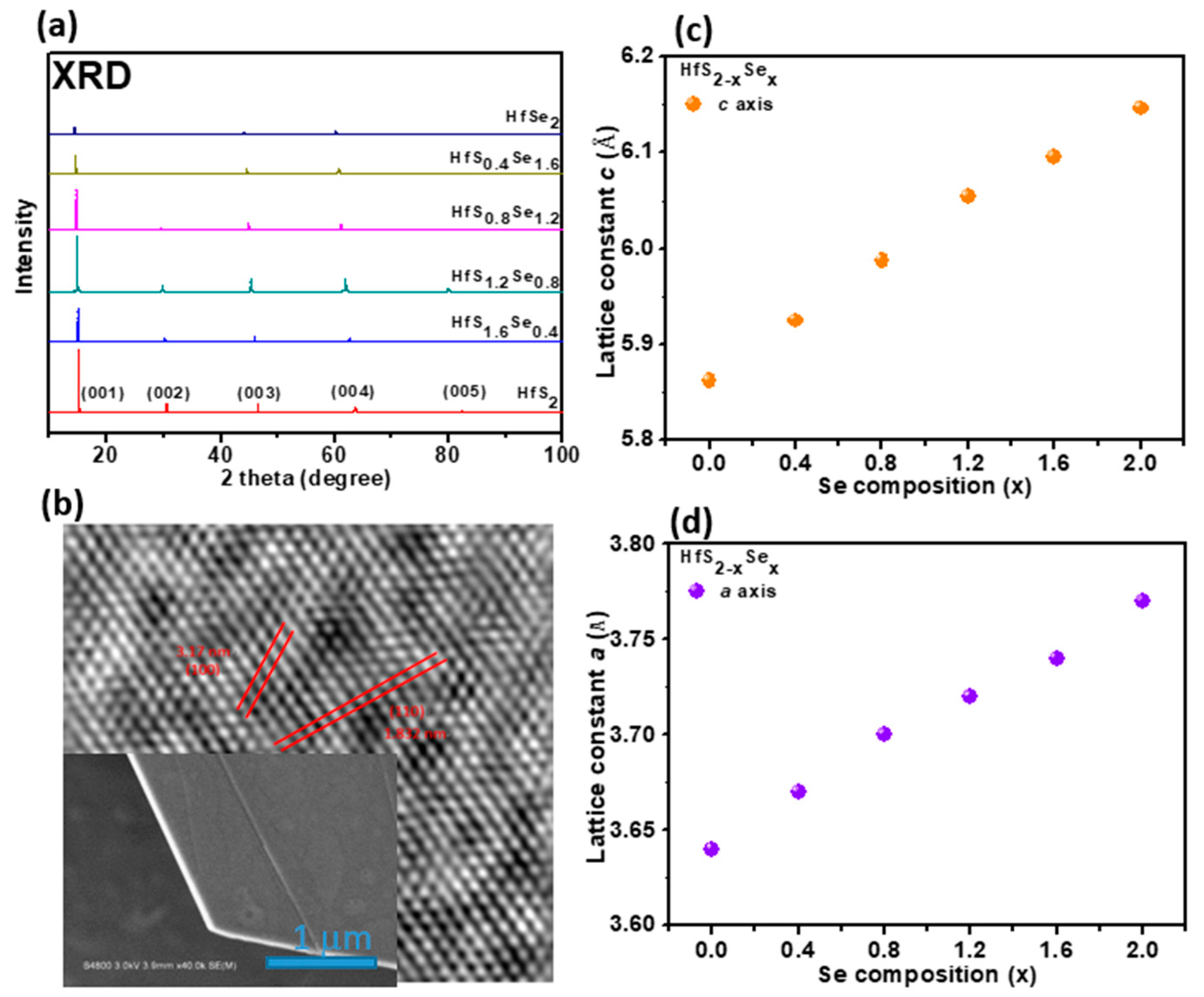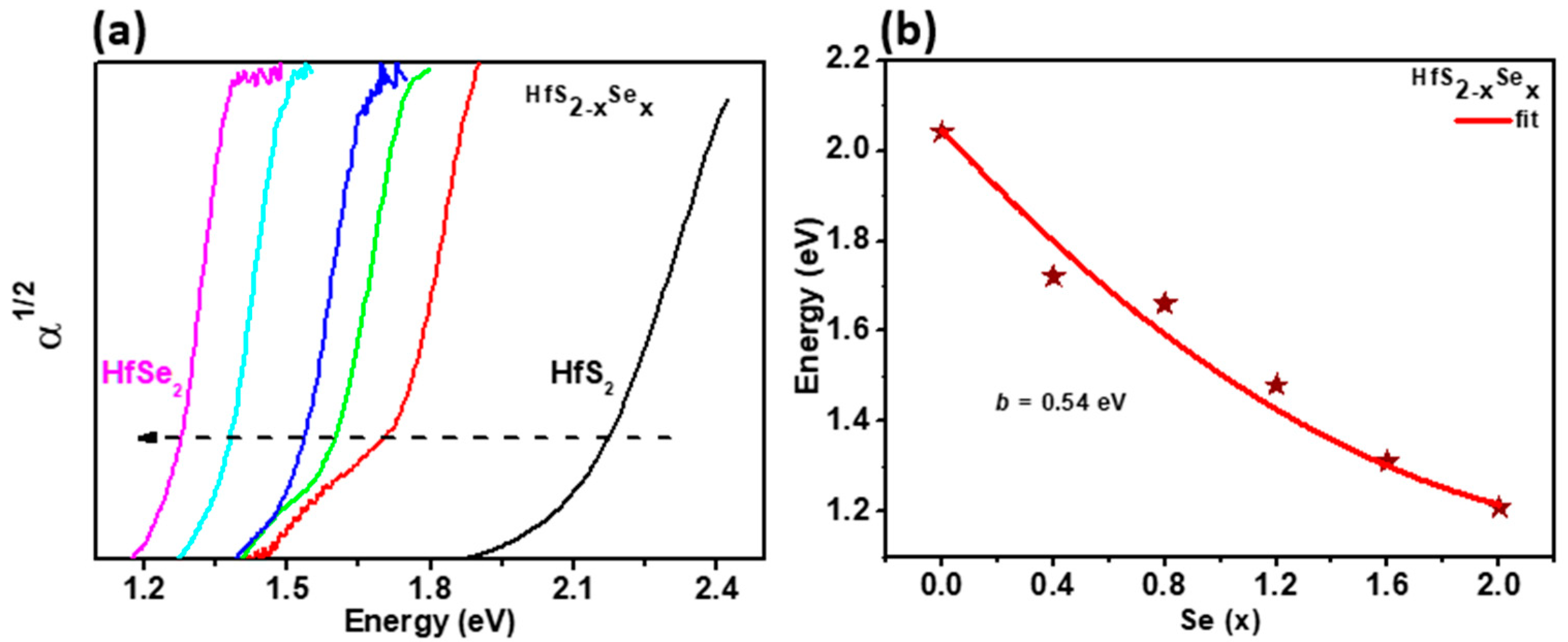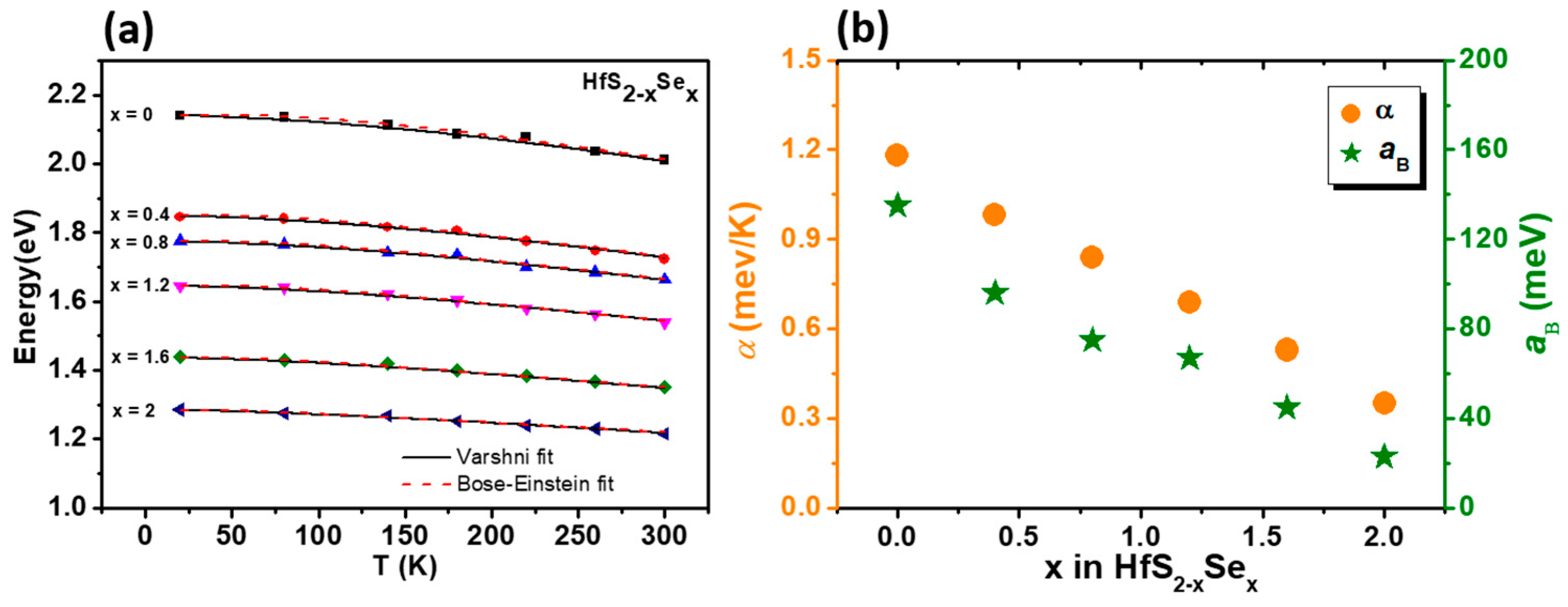Temperature-Dependent Absorption of Ternary HfS2−xSex 2D Layered Semiconductors
Abstract
:1. Introduction
2. Experimental
3. Results and Discussion
4. Conclusions
Supplementary Materials
Author Contributions
Funding
Institutional Review Board Statement
Informed Consent Statement
Data Availability Statement
Acknowledgments
Conflicts of Interest
Sample Availability
References
- Wang, Q.H.; Kalantar-Zadeh, K.; Kis, A.; Coleman, J.N.; Strano, M.S. Electronics and optoelectronics of two-dimensional transition metal dichalcogenides. Nat. Nanotechnol. 2012, 7, 699–712. [Google Scholar] [CrossRef] [PubMed]
- Mayorov, A.S.; Gorbachev, R.V.; Morozov, S.V.; Britnell, L.; Jalil, R.; Ponomarenko, L.A.; Blake, P.; Novoselov, K.S.; Watanabe, K.; Taniguchi, T.; et al. Micrometer-Scale Ballistic Transport in Encapsulated Graphene at Room Temperature. Nano Lett. 2011, 11, 2396–2399. [Google Scholar] [CrossRef] [PubMed]
- Balandin, A.A.; Ghosh, S.; Bao, W.; Calizo, I.; Teweldebrhan, D.; Miao, F.; Lau, C.N. Superior Thermal Conductivity of Single-Layer Graphene. Nano Lett. 2008, 8, 902–907. [Google Scholar] [CrossRef] [PubMed]
- Zeng, M.; Xiao, Y.; Liu, J.; Yang, K.; Fu, L. Exploring Two-Dimensional Materials toward the Next-Generation Circuits: From Monomer Design to Assembly Control. Chem. Rev. 2018, 118, 6236–6296. [Google Scholar] [CrossRef] [PubMed]
- Hwangbo, S.; Hu, L.; Hoang, A.T.; Choi, J.Y.; Ahn, J.-H. Wafer-scale monolithic integration of full-colour micro-LED display using MoS2 transistor. Nat. Nanotechnol. 2022, 17, 500–506. [Google Scholar] [CrossRef] [PubMed]
- Chhowalla, M.; Shin, H.S.; Eda, G.; Li, L.-J.; Loh, K.P.; Zhang, H. The chemistry of two-dimensional layered transition metal dichalcogenide nanosheets. Nat. Chem. 2013, 5, 263–275. [Google Scholar] [CrossRef] [PubMed]
- Chaves, A.; Azadani, J.G.; Alsalman, H.; Da Costa, D.R.; Frisenda, R.; Chaves, A.J.; Song, S.H.; Kim, Y.D.; He, D.; Zhou, J.; et al. Bandgap engineering of two-dimensional semiconductor materials. npj 2D Mater. Appl. 2020, 4, 29. [Google Scholar] [CrossRef]
- Duong, D.L.; Yun, S.J.; Lee, Y.H. van der Waals Layered Materials: Opportunities and Challenges. ACS Nano 2017, 11, 11803–11830. [Google Scholar] [CrossRef]
- Akinwande, D.; Huyghebaert, C.; Wang, C.-H.; Serna, M.I.; Goossens, S.; Li, L.-J.; Wong, H.-S.P.; Koppens, F.H.L. Graphene and two-dimensional materials for silicon technology. Nature 2019, 573, 507–518. [Google Scholar] [CrossRef]
- Tan, C.; Lai, Z.; Zhang, H. Ultrathin Two-Dimensional Multinary Layered Metal Chalcogenide Nanomaterials. Adv. Mater. 2017, 29, 1701392. [Google Scholar] [CrossRef]
- Li, M.Y.; Shi, Y.; Cheng, C.C.; Lu, L.S.; Lin, Y.C.; Tang, H.L.; Tsai, M.L.; Chu, C.W.; Wei, K.H.; He, J.H. Epitaxial growth of a monolayer WSe2-MoS2 lateral p-n junction with an atomically sharp interface. Science 2015, 349, 524–528. [Google Scholar] [CrossRef] [PubMed]
- Radisavljevic, B.; Radenovic, A.; Brivio, J.; Giacometti, V.; Kis, A. Single-layer MoS2 transistors. Nat. Nanotechnol. 2011, 6, 147–150. [Google Scholar] [CrossRef] [PubMed]
- Krasnozhon, D.; Lembke, D.; Nyffeler, C.; Leblebici, Y.; Kis, A. MoS2 Transistors Operating at Gigahertz Frequencies. Nano Lett. 2014, 14, 5905–5911. [Google Scholar] [CrossRef] [PubMed]
- Chen, M.-L.; Sun, X.; Liu, H.; Wang, H.; Zhu, Q.; Wang, S.; Du, H.; Dong, B.; Zhang, J.; Sun, Y.; et al. A FinFET with one atomic layer channel. Nat. Commun. 2020, 11, 1205. [Google Scholar] [CrossRef] [PubMed]
- Lan, Y.-W.; Chen, P.-C.; Lin, Y.-Y.; Li, M.-Y.; Li, L.-J.; Tu, Y.-L.; Yang, F.-L.; Chen, M.-C.; Li, K.-S. Scalable fabrication of a complementary logic inverter based on MoS2 fin-shaped field effect transistors. Nanoscale Horiz. 2019, 4, 683–688. [Google Scholar] [CrossRef]
- Yin, Z.; Li, H.; Li, H.; Jiang, L.; Shi, Y.; Sun, Y.; Lu, G.; Zhang, Q.; Chen, X.; Zhang, H. Single-layer MoS2 phototransistors. ACS Nano 2012, 6, 74–80. [Google Scholar] [CrossRef]
- Cao, X.; Tan, C.; Zhang, X.; Zhao, W.; Zhang, H. Solution-Processed Two-Dimensional Metal Dichalcogenide-Based Nanomaterials for Energy Storage and Conversion. Adv. Mater. 2016, 28, 6167–6196. [Google Scholar] [CrossRef]
- Li, H.; Shi, Y.; Chiu, M.-H.; Li, L.-J. Emerging energy applications of two-dimensional layered transition metal dichalcogenides. Nano Energy 2015, 18, 293–305. [Google Scholar] [CrossRef]
- Wu, S.; Zeng, Z.; He, Q.; Wang, Z.; Wang, S.J.; Du, Y.; Yin, Z.; Sun, X.; Chen, W.; Zhang, H. Electrochemically Reduced Single-Layer MoS2 Nanosheets: Characterization, Properties, and Sensing Applications. Small 2012, 8, 2264–2270. [Google Scholar] [CrossRef]
- Ping, J.; Fan, Z.; Sindoro, M.; Ying, Y.; Zhang, H. Recent advances in sensing applications of two-dimensional transition metal dichalcogenide nanosheets and their composites. Adv. Funct. Mater. 2017, 27, 1605817. [Google Scholar] [CrossRef]
- Yin, W.; Yu, J.; Lv, F.; Yan, L.; Zheng, L.R.; Gu, Z.; Zhao, Y. Functionalized Nano-MoS2 with Peroxidase Catalytic and Near-Infrared Photothermal Activities for Safe and Synergetic Wound Antibacterial Applications. ACS Nano 2016, 10, 11000–11011. [Google Scholar] [CrossRef] [PubMed]
- Cheng, L.; Liu, J.; Gu, X.; Gong, H.; Shi, X.; Liu, T.; Wang, C.; Wang, X.; Liu, G.; Xing, H.; et al. PEGylated WS2Nanosheets as a Multifunctional Theranostic Agent for in vivo Dual-Modal CT/Photoacoustic Imaging Guided Photothermal Therapy. Adv. Mater. 2013, 26, 1886–1893. [Google Scholar] [CrossRef] [PubMed]
- Kumar, P.; Roy, S.; Sarkar, A.; Jaiswal, A. Reusable MoS2-Modified Antibacterial Fabrics with Photothermal Disinfection Properties for Repurposing of Personal Protective Masks. ACS Appl. Mater. Interfaces 2021, 13, 12912–12927. [Google Scholar] [CrossRef] [PubMed]
- Liu, C.; Kong, D.; Hsu, P.-C.; Yuan, H.; Lee, H.-W.; Liu, Y.; Wang, H.; Wang, S.; Yan, K.; Lin, D.; et al. Rapid water disinfection using vertically aligned MoS2 nanofilms and visible light. Nat. Nanotechnol. 2016, 11, 1098–1104. [Google Scholar] [CrossRef] [PubMed]
- Ai, K.; Ruan, C.; Shen, M.; Lu, L. MoS2Nanosheets with Widened Interlayer Spacing for High-Efficiency Removal of Mercury in Aquatic Systems. Adv. Funct. Mater. 2016, 26, 5542–5549. [Google Scholar] [CrossRef]
- Gaiser, C.; Zandt, T.; Krapf, A.; Serverin, R.; Janowitz, C.; Manzke, R. Band-gap engineering with HfSxSe2-x. Phys. Rev. B 2004, 69, 075205. [Google Scholar] [CrossRef]
- Yue, R.; Barton, A.T.; Zhu, H.; Azcatl, A.; Pena, L.F.; Wang, J.; Peng, X.; Lu, N.; Cheng, L.; Addou, R.; et al. HfSe2 Thin Films: 2D Transition Metal Dichalcogenides Grown by Molecular Beam Epitaxy. ACS Nano 2014, 9, 474–480. [Google Scholar] [CrossRef]
- Zhang, W.; Huang, Z.; Zhang, W.; Li, Y. Two-dimensional semiconductors with possible high room temperature mobility. Nano Res. 2014, 7, 1731–1737. [Google Scholar] [CrossRef]
- Kanazawa, T.; Amemiya, T.; Ishikawa, A.; Upadhyaya, V.; Tsuruta, K.; Tanaka, T.; Miyamoto, Y. Few-layer HfS2 transistors. Sci. Rep. 2016, 6, 22277. [Google Scholar] [CrossRef]
- Kang, M.; Rathi, S.; Lee, I.; Lim, D.; Wang, J.; Li, L.; Khan, M.A.; Kim, G.H. Electrical characterization of multilayer HfSe2 field-effect transistors on SiO2 substrate. Appl. Phys. Lett. 2015, 106, 143108. [Google Scholar] [CrossRef]
- Kang, M.; Rathi, S.; Lee, I.; Li, L.; Khan, M.A.; Lim, D.; Lee, Y.; Park, J.; Yun, S.J.; Youn, D.-H.; et al. Tunable electrical properties of multilayer HfSe2field effect transistors by oxygen plasma treatment. Nanoscale 2016, 9, 1645–1652. [Google Scholar] [CrossRef] [PubMed]
- Yin, L.; Xu, K.; Wen, Y.; Wang, Z.; Huang, Y.; Wang, F.; Shifa, T.A.; Cheng, R.; Ma, H.; He, J. Ultrafast and ultrasensitive phototransistors based on few-layered HfSe2. Appl. Phys. Lett. 2016, 109, 213105. [Google Scholar] [CrossRef]
- Wang, H.; Lan, Y.-S.; Dai, B.; Zhang, X.-W.; Wang, Z.-G.; Ge, N.-N. Improved Thermoelectric Performance of Monolayer HfS2 by Strain Engineering. ACS Omega 2021, 6, 29820–29829. [Google Scholar] [CrossRef] [PubMed]
- King’ori, G.W.; Ouma, C.N.M.; Mishra, A.K.; Amolo, G.O.; Makau, N.W. Two-dimensional graphene-HfS2 van der Walls heterostructure as electrode material for alkali-ion batteries. RSC Adv. 2020, 10, 30127–30138. [Google Scholar] [CrossRef]
- Wang, D.; Zhang, X.; Guo, G.; Gao, S.; Li, X.; Meng, J.; Yin, Z.; Liu, H.; Gao, M.; Cheng, L.C.; et al. Large-area synthesis of layered HfS2(1−x)Se2x alloys with fully tunable chemical compositions and bandgaps. Adv. Mater. 2018, 30, 1803285. [Google Scholar] [CrossRef]
- Shan, F.K.; Kim, B.I.; Liu, G.X.; Liu, Z.F.; Sohn, J.Y.; Lee, W.J.; Shin, B.C.; Yu, Y.S. Blueshift of near band edge emission in Mg doped ZnO thin films and aging. J. Appl. Phys. 2004, 95, 4772–4776. [Google Scholar] [CrossRef]
- Li, H.; Duan, X.; Wu, X.; Zhuang, X.; Zhou, H.; Zhang, Q.; Zhu, X.; Hu, W.; Ren, P.; Guo, P.; et al. Growth of alloy MoS2xSe2(1-x) nanosheets with fully tunable chemical compositions and optical properties. J. Am. Chem. Soc. 2014, 136, 3756–3759. [Google Scholar] [CrossRef]
- Razeghizadeh, M.; Pourfath, M. First principles study on structural, electronic and optical properties of HfS2(1−x)Se2x and ZrS2(1−x)Se2x ternary alloys. RSC Adv. 2022, 12, 14061. [Google Scholar] [CrossRef]
- Lin, D.-Y.; Hsu, H.-P.; Tsai, C.-F.; Wang, C.-W.; Shih, Y.-T. Temperature Dependent Excitonic Transition Energy and Enhanced Electron-Phonon Coupling in Layered Ternary SnS2−xSex Semiconductors with Fully Tunable Stoichiometry. Molecules 2021, 26, 2184. [Google Scholar] [CrossRef]
- El-Shazly, A.A.; El-Naby, M.M.H.; Kenawy, M.A.; El-Nahass, M.M.; El-Shair, H.T.; Ebrahim, A.M. Optical properties of ternary ZnSxSe1-x polycrystalline thin films. Appl. Phys. A 1985, 36, 51–53. [Google Scholar] [CrossRef]
- Beladjal, K.; Kadri, A.; Zitouni, K.; Mimouni, K. Bandgap bowing parameters of III-nitrides semiconductors alloys. Superlattices Microstruct. 2021, 155, 106901. [Google Scholar] [CrossRef]
- Tauc, J.; Grigorovici, R.; Vancu, A. Optical Properties and Electronic Structure of Amorphous Germanium. Phys. Status Solidi B 1966, 15, 627–637. [Google Scholar] [CrossRef]
- Yu, P.Y.; Cardona, M. ; Fundamentals of Semiconductors; Springer: Berlin/Heidelberg, Germany, 1996; pp. 259–266. [Google Scholar]
- Varshni, Y. Temperature dependence of the energy gap in semiconductors. Physica 1967, 34, 149–154. [Google Scholar] [CrossRef]
- Trivedi, D.B.; Turgut, G.; Qin, Y.; Sayyad, M.Y.; Hajra, D.; Howell, M.; Liu, L.; Yang, S.; Patoary, N.H.; Li, H.; et al. Room-Temperature Synthesis of 2D Janus Crystals and their Heterostructures. Adv. Mater. 2020, 32, e2006320. [Google Scholar] [CrossRef]
- Kopaczek, J.; Zelewski, S.; Yumigeta, K.; Sailus, R.; Tongay, S.; Kudrawiec, R. Temperature dependence of the indirect gap and the direct optical transitions at the high-symmetry point of the brillouin zone and band nesting in MoS2, MoSe2, MoTe2, WS2, and WSe2. Crystals. J. Phys. Chem. C 2022, 126, 5665–5674. [Google Scholar] [CrossRef] [PubMed]
- Chung, S.Y.; Lin, D.Y.; Huang, Y.S.; Tiong, K.-K. Piezoreflectance study of InP near the absorption edge. Semicond. Sci. Technol. 1996, 11, 1850–1856. [Google Scholar] [CrossRef]
- Malikova, L.; Krystek, W.; Pollak, F.H.; Dai, N.; Cavus, A.; Tamargo, M.C. Temperature dependence of the direct gaps of ZnSe and Zn0.56Cd0.44Se. Phys. Rev. B 1996, 54, 1819–1924. [Google Scholar] [CrossRef]
- Lautenschlager, P.; Garriga, M.; Cardona, M. Temperature dependence of the interband critical-point parameters of InP. Phys. Rev. B 1987, 36, 4813–4820. [Google Scholar] [CrossRef]
- Lautenschlager, P.; Garriga, M.; Logothetidis, S.; Cardona, M. Interband critical points of GaAs and their temperature dependence. Phys. Rev. B 1987, 35, 9174–9189. [Google Scholar] [CrossRef]
- Lin, D.-Y.; Guo, B.-C.; Dai, Z.-Y.; Hsu, H.-P. PbI2 Single Crystal Growth and Its Optical Property Study. Crystals 2019, 9, 589. [Google Scholar] [CrossRef] [Green Version]
- Manoogian, A.; Leclerc, A. Determination of the dilation and vibrational contributions to the energy band gaps in germanium and silicon. Phys. Status Solidi 1979, 92, K23–K27. [Google Scholar] [CrossRef]





| HfS2−xSex | Hf | S | Se |
|---|---|---|---|
| HfS2 | 34.25 | 65.74 | |
| HfS1.6Se0.4 | 34.32 | 53.73 | 10.93 |
| HfS1.2Se0.8 | 37.50 | 42.44 | 20.04 |
| HfS0.8Se1.2 | 34.32 | 28.39 | 37.28 |
| HfS0.4Se1.6 | 34.83 | 16.75 | 48.41 |
| HfSe2 | 35.87 | 64.12 |
| Materials | Feature | E(0) | α | β | aB | ΘB | dE/dT |
|---|---|---|---|---|---|---|---|
| (eV) | (m eV/K) | (K) | (m eV) | (K) | (m eV/K) | ||
| HfS2 a | Eg | 2.141 | 1.18 | 496 | 135 | 342 | −0.75 |
| HfS1.6Se0.4 a | 1.849 | 0.98 | 425 | 96 | 288 | −0.66 | |
| HfS1.2Se0.8 a | 1.775 | 0.84 | 367 | 75 | 258 | −0.50 | |
| HfS0.8Se1.2 a | 1.646 | 0.69 | 300 | 67 | 250 | −0.49 | |
| HfS0.4Se1.6 a | 1.436 | 0.54 | 247 | 45 | 214 | −0.43 | |
| HfSe2 a | 1.284 | 0.35 | 169 | 23 | 161 | −0.32 | |
| MoSSe b | 1.74 | 0.395 | 216 | ||||
| WSSe b | 1.87 | 0.59 | 260 | ||||
| GaAs c | Eg | 1.517 | 0.55 | 225 | 57 | 240 | |
| InP d | Eg | 1.424 | 1.02 | 823 | 35.9 | 204 | |
| ZnSe e | Eg | 2.800 | 0.73 | 295 | 73 | 260 | |
| Si f | Eg | 1.170 | 4.73 | 636 |
Publisher’s Note: MDPI stays neutral with regard to jurisdictional claims in published maps and institutional affiliations. |
© 2022 by the authors. Licensee MDPI, Basel, Switzerland. This article is an open access article distributed under the terms and conditions of the Creative Commons Attribution (CC BY) license (https://creativecommons.org/licenses/by/4.0/).
Share and Cite
Lin, D.-Y.; Hsu, H.-P.; Wang, C.-W.; Chen, S.-W.; Shih, Y.-T.; Hwang, S.-B.; Sitarek, P. Temperature-Dependent Absorption of Ternary HfS2−xSex 2D Layered Semiconductors. Materials 2022, 15, 6304. https://doi.org/10.3390/ma15186304
Lin D-Y, Hsu H-P, Wang C-W, Chen S-W, Shih Y-T, Hwang S-B, Sitarek P. Temperature-Dependent Absorption of Ternary HfS2−xSex 2D Layered Semiconductors. Materials. 2022; 15(18):6304. https://doi.org/10.3390/ma15186304
Chicago/Turabian StyleLin, Der-Yuh, Hung-Pin Hsu, Cheng-Wen Wang, Shang-Wei Chen, Yu-Tai Shih, Sheng-Beng Hwang, and Piotr Sitarek. 2022. "Temperature-Dependent Absorption of Ternary HfS2−xSex 2D Layered Semiconductors" Materials 15, no. 18: 6304. https://doi.org/10.3390/ma15186304
APA StyleLin, D.-Y., Hsu, H.-P., Wang, C.-W., Chen, S.-W., Shih, Y.-T., Hwang, S.-B., & Sitarek, P. (2022). Temperature-Dependent Absorption of Ternary HfS2−xSex 2D Layered Semiconductors. Materials, 15(18), 6304. https://doi.org/10.3390/ma15186304






